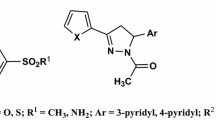Abstract.
Objective and Design: Two structurally related compounds, meloxicam (Mel) and its structural 4′-isomer (4′-Mel), were compared to examine the role of a slightly different chemical structure on cyclooxygenase (COX) selectivity in in vitro and in vivo experimental models.¶Material or Subjects: In vitro studies were performed using human whole blood obtained from healthy volunteers, in vivo studies were performed in rats.¶Treatment: A concentration-response curve was obtained in the whole blood assay for Mel, 4′-Mel, indomethacin, piroxicam and diclofenac. These were used to calculate the respective IC50 values of either prostaglandin E2 (PGE2) or thromboxane B2 (TxB2). Similarly, a dose-response curve was obtained for Mel, 4′-Mel and piroxicam when measuring in vivo prostaglandin production, anti-inflammatory activity and gastric tolerance to determine the dose resulting in a 50% reduction of the each parameter.¶Methods: COX selectivity was investigated in vitro using a human whole blood assay. PGE2 synthesis in vivo was measured in inflammatory exudate, in the stomach and kidneys of rats. Anti-inflammatory effects were measured in an adjuvant arthritis model and gastric tolerance was tested in an ulcerogenicity model in vivo in rats.¶Results: In the human whole blood assay, the ratio of IC50 values for COX-1 vs. COX-2 inhibition was 13 for Mel and 1.8 for 4′-Mel. In inflammatory exudate in rats, Mel and 4′-Mel inhibited PGE2 synthesis to a similar extent, ID50 values ∼ 0.3 mg/kg. In contrast, Mel was a weaker inhibitor of PG synthesis than 4′-Mel in the rat stomach and in the rat kidney. Paw swelling was reduced by 50% with 0.1 and 0.2 mg/kg for Mel and 4′-Mel, respectively, in the rat adjuvant arthritis model. Gastric tolerance (UD50) was 2.4 mg/kg for Mel and 0.4 mg/kg for 4′-Mel.¶Conclusions: These data demonstrate that the in vitro and in vivo pharmacological profile of meloxicam is structurally dependent and that minor structural changes can lead to significant differences in the selectivity for COX-1 and COX-2 in vitro and to different profiles in vivo suggesting different therapeutic potential.
Similar content being viewed by others
Author information
Authors and Affiliations
Additional information
Received 12 August 1997; returned for revision 8 September 1997; returned for final revision 10 March 1998; accepted by M.J. Parnham 8 April 1998
Rights and permissions
About this article
Cite this article
Pairet, M., van Ryn, J., Schierok, H. et al. Differential inhibition of cyclooxygenases-1 and -2 by meloxicam and its 4′-isomer. Inflamm. res. 47, 270–276 (1998). https://doi.org/10.1007/s000110050329
Published:
Issue Date:
DOI: https://doi.org/10.1007/s000110050329



